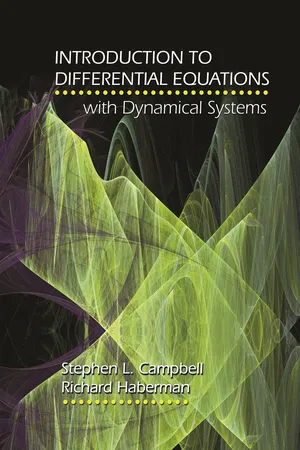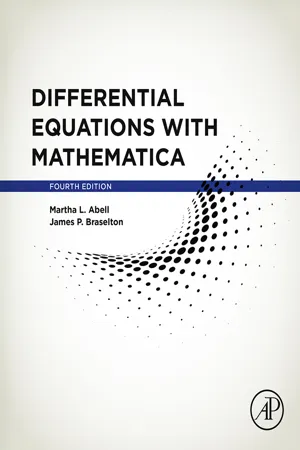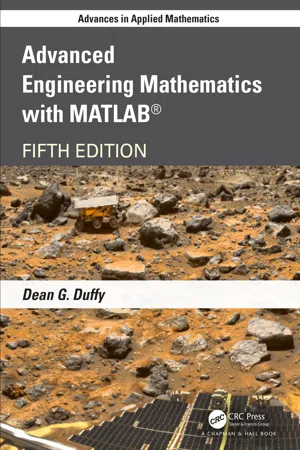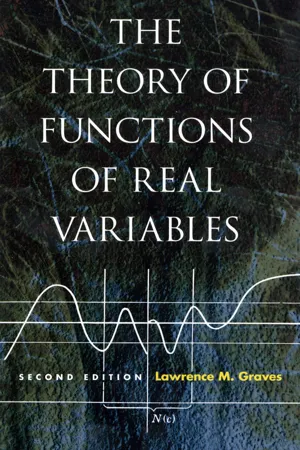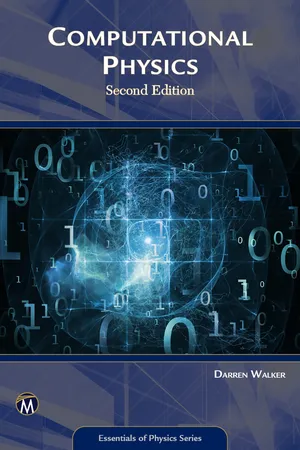Mathematics
Solutions to Differential Equations
Solutions to differential equations refer to the functions that satisfy a given differential equation. These solutions can be found through various methods, such as separation of variables, integrating factors, and using specific techniques for different types of differential equations (e.g., linear, nonlinear, first-order, second-order). The solutions provide a way to model and understand the behavior of systems in various fields, including physics, engineering, and biology.
Written by Perlego with AI-assistance
Related key terms
Related key terms
1 of 4
Related key terms
1 of 3
8 Key excerpts on "Solutions to Differential Equations"
- eBook - ePub
Mathematical Methods for Finance
Tools for Asset and Risk Management
- Sergio M. Focardi, Frank J. Fabozzi, Turan G. Bali(Authors)
- 2013(Publication Date)
- Wiley(Publisher)
The solutions to a differential equation or system of differential equations can be as simple as explicit formulas. When an explicit formula is not possible to obtain, various numerical methods can be used to approximate a solution. Even in the absence of an exact solution, properties of solutions of a differential equation can be determined. A large number of properties of differential equations have been established over the last three centuries. In this chapter, we provide only a brief introduction to the concept of differential equations and their properties, limiting our discussion to the principal concepts. We do not cover stochastic differential equations.DIFFERENTIAL EQUATIONS DEFINED A differential equation is a condition expressed as a functional link between one or more functions and their derivatives. It is expressed as an equation (that is, as an equality between two terms). A solution of a differential equation is a function that satisfies the given condition. For example, the conditionequates to zero a linear relationship between an unknown function Y (x ), its first and second derivatives Y′ (x ), Y ″ (x ), and a known function b (x ). (In some equations, we denote the first and second derivatives by a single and double prime, respectively.) The unknown function Y (x ) is the solution of the equation that is to be determined.There are two broad types of differential equations: ordinary differential equations and partial differential equations. Ordinary differential equations are equations or systems of equations involving only one independent variable. Another way of saying this is that ordinary differential equations involve only total derivatives. In contrast, partial differential equations are differential equations or systems of equations involving partial derivatives. That is, there is more than one independent variable.ORDINARY DIFFERENTIAL EQUATIONS In full generality, an ordinary differential equation (ODE) can be expressed as the following relationship:where Y(m )(x ) denotes the m th derivative of an unknown function Y (x ). If the equation can be solved for the n - eBook - ePub
- Clayton R. Paul(Author)
- 2011(Publication Date)
- Wiley-IEEE Press(Publisher)
to use mathematical skills to determine what the equations governing the system are telling us about how the system behaves.4.2 WHERE THEY ARISE: THE MEANING OF A SOLUTIONIn Chapter 1 we showed examples of where differential equations arise in electrical and mechanical engineering systems. Ordinary differential equations can be found routinely in all of engineering.How do we know that a particular formula for x(t) is a solution to the differential equation? The simple method is to substitute it into the differential equation, perform the required differentiations, and see if satisfies the equation [i.e., both sides of (4.1) are the same]. However, unlike algebraic equations, differential equations have an infinite number of possible solutions. So we need some additional information to pin down which of these is the actual solution for the problem we are investigating. This additional information comprises what are called the initial conditions for the specific problem being investigated. For example, consider the first-order equation in (4.1a). For the specific problem that this differential equation describes, we would need to specify an additional initial condition for the value of x (t) at some starting time, say t = 0, which we denote as x (0). So the complete specification of the problem would be to specify (a) the differential equation and (b) the initial condition as(4.1a)Once we have obtained a solution x(t) that satisfies this differential equation and the initial condition, we can say that the solution x(t) is valid for all t ≥ 0. Similarly, the second-order equation in (4.1b) requires two initial conditions: x(0) and its derivative att = 0,dx(t)/dt\t=0 ≡ - Stephen L. Campbell, Richard Haberman(Authors)
- 2011(Publication Date)
- Princeton University Press(Publisher)
CHAPTER 1
First-Order Differential Equations and Their Applications
1.1 Introduction to Ordinary Differential Equations
Differential equations are found in many areas of mathematics, science, and engineering. Students taking a first course in differential equations have often already seen simple examples in their mathematics, physics, chemistry, or engineering courses. If you have not already seen differential equations, go to the library or Web and glance at some books or journals in your major field. You may be surprised to see the way in which differential equations dominate the study of many aspects of science and engineering.Applied mathematics involves the relationships between mathematics and its applications. Often the type of mathematics that arises in applications is differential equations. Thus, the study of differential equations is an integral part of applied mathematics. Applied mathematics is said to have three fundamental aspects, and this course will involve a balance of the three:- The modeling process by which physical objects and processes are described by physical laws and mathematical formulations. Since so many physical laws involve rates of change (or the derivative), differential equations are often the natural language of science and engineering.
- The analysis of the mathematical problems that are posed. This involves the complete investigation of the differential equation and its solutions, including detailed numerical studies. We will say more about this shortly.
- However, the mathematical solution of the differential equation does not complete the overall process. The interpretation of the solution of the differential equation in the context of the original physical problem must be given, and the implications further analyzed.
Using the qualitative- Christopher Jekeli(Author)
- 2023(Publication Date)
- De Gruyter(Publisher)
t . Certain classes of differential equations have solutions that can be found analytically using various rules or formulas and others have no analytic solution. In the general case of arbitrary equations, if an analytic solution exists, it must be guessed and checked by back-substitution (that is, a putative solution certainly must satisfy the differential equation). With today’s modern computational capabilities, numerical methods are more common than in the past and often the only viable course to follow.Since solving a differential equation, in essence, involves an integration, it is important to note that the solution is incomplete without a constant of integration. The solution to a differential equation of order m requires m integrations, implying that m constants must be specified. These constants are also known as initial conditions, and we may think of them as indicating the values of the function and itsm − 1derivatives at some (usually) initial time,t 0. Thus (2.1) should include the following statement,(2.2)y jt 0=μ j, j = 0 , … , m − 1 ,where theμ jare constants with given values.Differential equations pervade the study of inertial navigation systems, from the dynamics of the sensors to the determination of a navigation solution and the analysis of the associated errors. In particular, the differential equations associated with coordinate transformations that we already encountered in Section 1.4 play an essential role in the navigation solution. However, it is clearly not the intent here to fully develop the theory of differential equations. Only results useful to our exposition of INS and its applications will be derived. This includes a general treatment of linear ordinary differential equations with discussion of analytic solutions and one method of numerical solution.- eBook - ePub
- Martha L. Abell, James P. Braselton(Authors)
- 2016(Publication Date)
- Academic Press(Publisher)
The advantages of using Mathematica in the study of differential equations are numerous, but perhaps some of the most useful include that of being able to produce the graphics associated with solutions of differential equations as well as generating very accurate numerical solutions of equations that can only be solved numerically. This is in the discussion of applications because many physical situations are modeled with differential equations. For example, we will see that the motion of a pendulum can be modeled by a differential equation. When we solve the problem of the motion of a pendulum, we use technology to actually watch the pendulum move. The same is true for the motion of a mass attached to the end of a spring as well as many other problems. In having this ability, the study of differential equations becomes much more meaningful as well as interesting.If you are a beginning Mathematica user and, especially, new to Version 10, the Appendix contains an introduction to Mathematica, including discussions about entering and evaluating commands, and taking advantage of Mathematica’s extensive help facilities.Although Chapter 1 is short in length, Chapter 1 introduces examples that will be investigated in subsequent chapters. Also, the vocabulary introduced in Chapter 1 will be used throughout the text. Consequently, even though, to a large extent, it may be read quickly, subsequent chapters will take advantage of the terminology and techniques discussed here.1.1 Definitions and Concepts
We begin our study of differential equations by explaining what a differential equation is.Definition 1 Differential EquationA differential equation is an equation that contains the derivative or differentials of one or more dependent variables with respect to one or more independent variables. If the equation contains only ordinary derivatives (of one or more dependent variables) with respect to a single independent variable, the equation is called an ordinary differential equation .Example 1.1.1 Discuss properties of the following differential equations.1.d y / d x =and dy /dx + du /dx = u + x 2 yx 2/y 2cos y2.( y − 1 ) d x + x cos y d y = 13.xy ″+ xy ′+y = 0x 2−n 24.= ( a − b y ) xd xd t= ( − m + n x ) y .d yd tSolution - eBook - ePub
- Dean G. Duffy(Author)
- 2021(Publication Date)
- Chapman and Hall/CRC(Publisher)
First-Order Ordinary Differential EquationsA differential equation is any equation that contains the derivatives or differentials of one or more dependent variables with respect to one or more independent variables. Because many of the known physical laws are expressed as differential equations, a sound knowledge of how to solve them is essential. In the next two chapters we present the fundamental methods for solving ordinary differential equations — a differential equation that contains only ordinary derivatives of one or more dependent variables. Later, we show in Section 7.7 how Laplace transform methods can be used to solve ordinary differential equations, while systems of linear ordinary differential equations are treated in Section 3.6 . Solutions for partial differential equations—a differential equation involving partial derivatives of one or more dependent variables of two or more independent variables—are given in Chapters 8 , 9 , and 10 .1.1 CLASSIFICATION OF DIFFERENTIAL EQUATIONS
Differential equations are classified three ways: by type, order, and linearity. There are two types: ordinary and partial differential equations, which have already been defined. Examples of ordinary differential equations include− 2 y = x ,d yd x(1.1.1)(d x + 4 y d y = 0 ,x − y)(1.1.2)and+d ud x= 1 + 5 x ,d vd x(1.1.3)On the other hand, examples of partial differential equations include+ 2d 2ydx 2+ y = sind yd x( x ).(1.1.4)+∂ u∂ x= 0∂ u∂ y(1.1.5)andy+ x∂ u∂ x= 2 u ,∂ u∂ y(1.1.6)+ 2∂ 2u∂t 2=∂ u∂ t.∂ 2u∂x 2(1.1.7)In the examples that we have just given, we have explicitly written out the differentiation operation. However, from calculus we know that dy/dx can also be written y’. Similarly, the partial differentiation operator ∂4 u/∂x2 ∂y2 is sometimes written uxxyy . We will also use this notation from time to time.The order - eBook - ePub
The Theory of Functions of Real Variables
Second Edition
- Lawrence M Graves(Author)
- 2012(Publication Date)
- Dover Publications(Publisher)
CHAPTER IX ORDINARY DIFFERENTIAL EQUATIONS1. Conditions Ensuring the Existence of Solutions. —In the following we shall let x denote the single real independent variable, and let y denote the dependent variables, of which there may be any finite number. Derivatives with respect to x will be denoted by accents. Thus a system of differential equations involving only first derivatives may be written in the formAn equation or a system of equations involving derivatives of higher orders may always be reduced to a system of the form (1:1) by the introduction of new dependent variables. For example, consider the equationIf we set y1 = y, y2 = y′, equation (1:2) is equivalent to the systemWe shall begin by considering systems of the formin which the derivatives are expressed explicitly as functions of x and y. Here it is understood that the number of equations is the same as the number of dependent variables y which are to be determined as functions of x. If there is only one equation and one variable y, the equation (1:4) may be pictured as attaching to each point in a region of the xy-plane a line whose slope is f(x, y). The problem of solving the differential equation is that of finding a curve having as its tangent at each point the line attached to that point. The extension of this geometrical interpretation to more dimensions is immediate.By a solution of (1:4) we shall mean a differentiable function y(x) defined on an (open or closed) interval (a, b) and such that y′(x) = f(x, y(x)) identically on (a, b). The set of all points (x, y(x)) with x on (a, b) is called thegraphof the solution. There will in general be infinitely many solutions. If we adjoin to the differential equation (1:4) initial conditions of the form y(ξ) = η, then the solution on an interval (a, b) containing ξ is uniquely determined, provided the function f has suitable properties. The requirement that the solution shall satisfy the initial condition y(ξ) = η is expressed geometrically by saying that the graph of the solution shall pass through the point (ξ, η). We shall be interested in studying the properties of the solution as a function y(x, ξ, η) of x and these initial values. The variables ξ and η constitute a special choice of the constants of integration, convenient for theoretical purposes. In a sufficiently restricted domain the complete family of solutions is obtained with the value of ξ fixed. In the first theorem to be proved the domain of the function f - eBook - ePub
- Darren Walker(Author)
- 2022(Publication Date)
- Mercury Learning and Information(Publisher)
6 ORDINARY DIFFERENTIAL EQUATIONSPhysics is mostly concerned with phenomena that are in flux, for instance, things that change either in time or space or both, and many of the laws of physics are most conveniently formulated in terms of differential equations; formulas that relate derivatives to functions. As an example, consider Newton’s second law of motion for a particle of mass, m , in one-dimensional motion under a force field :(6.1)This is a second-order differential equation as we are taking the second derivative of the displacement, x , called the dependent variable, with respect to time, t , called the independent variable. The force field can be referred to as the derivative function.Finding the numerical solution of differential equations is one of the most common tasks in computational physics as many of these equations become analytically insoluble (or at least difficult to solve) when you include realistic physical processes.6.1 CLASSIFICATION OF DIFFERENTIAL EQUATIONS6.1.1 Types of Differential EquationsDifferential equations can be categorized into two major groups, ordinary differential equations (ODE) and partial differential equations (PDE). The difference between the two is that ODEs only have one independent variable (they still can have any number of dependent variables) and PDEs can have any number of independent variables as well as any number of dependent variables. Simple harmonic motion (SHM) in one dimension is an example of an ODE:, (6.2)where m is the mass of the body in motion, k is the so-called spring constant, and x represents the displacement from some equilibrium position. Here time, t , is the only independent variable and x is the dependent variable that is a function of the independent variable, normally written as
Index pages curate the most relevant extracts from our library of academic textbooks. They’ve been created using an in-house natural language model (NLM), each adding context and meaning to key research topics.
Explore more topic indexes
Explore more topic indexes
1 of 6
Explore more topic indexes
1 of 4


